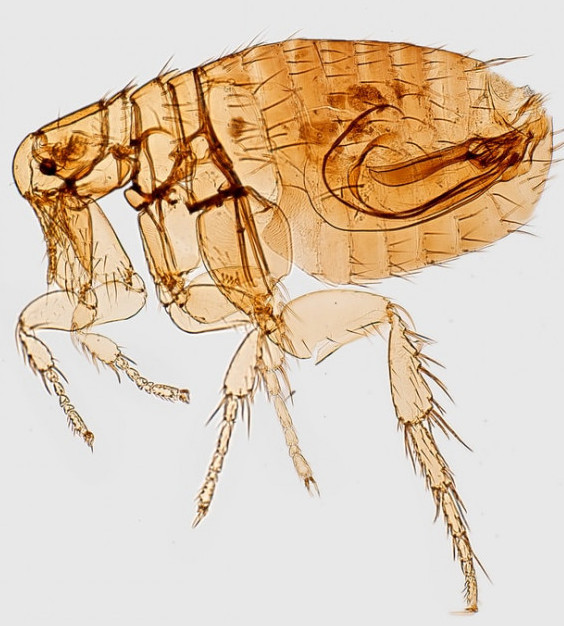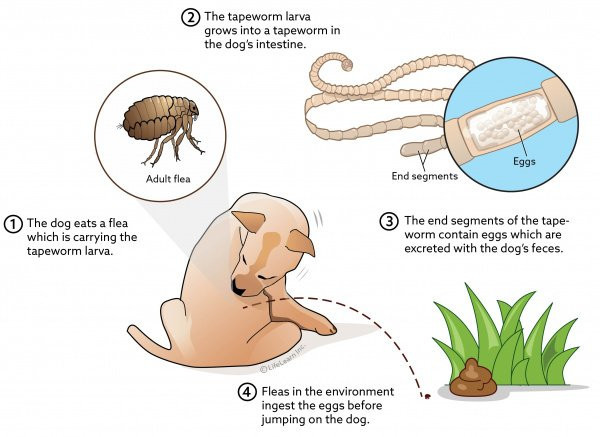
A common affliction for dogs is FLEAS. Fleas are a horrible nuisance! Besides affecting your dog’s health and comfort, fleas can easily infest your home and attack your family as well. Here is what you need to know:
What are Fleas?
Fleas are wingless insects that survive by hematophagy, the consumption of blood from a host organism. There are more than 2,000 species of fleas which have adapted to feeding on a variety of hosts, including dogs, cats, humans as well as a multitude of other animals.

Fleas get to their hosts, not by wings, but by jumping onto them. They are capable of a vertical leap of 7 inches and a distance of more than a foot. Being an average size of 1/6 to 1/8 of an inch in length, their jumping ability in comparison is phenomenal. Fleas are able to jump roughly at least 50 times more distance than their size.
Once fleas easily jump onto your dog, they’ll bite to feed on blood and then start to lay eggs.
Fleas have four life cycle stages:
- Egg – A female flea can lay up to 2,000 eggs which hatch in 1 – 10 days into:
- Larvae that move about on the host, feeding on blood and flea dirt (digested blood from adult fleas). These larvae then transform into:
- Pupa where they form cocoons, waiting for up to a year in carpet, sofa, and elsewhere in your home for a host to appear where they hatch and become:
- Adults who infest their animal hosts.
A consideration impacting the occurrence of fleas is climate. Fleas are either killed or lay dormant in freezing weather. Once the weather warms up, dormant fleas are revitalized. In areas with warm weather year-round, fleas are year-round pests.

Effects
Fleas can cause a variety of negative health issues for your pet. The most common initial effect is flea bite dermatitis or an allergic reaction to flea saliva after being bit. These bites cause intense itching and subsequent scratching by your dog which may likely cause breaks in the skin, scabbing and possible infection. At this point, a visit to a veterinarian may be required for medication to treat the allergic reaction and infection.
Another problem caused by fleas are tapeworms. If your dog ingests a flea afflicted with tapeworms, then it too will become a tapeworm host. These tapeworms then grow inside your dog, from maggot-size to as long as a foot. A tapeworm causes an itchy rear end for your dog and possible weight loss.

A serious flea infestation could result in flea bite anemia. In this occurrence, the fleas draw so much blood from its host, that its red blood cell count diminishes to the point of them becoming anemic. In serious cases, this could result in a medical emergency and even death if left untreated.
Treatment and Prevention
For flea treatment and prevention for your dog, there are various options to consider. First, there are oral versus topical treatments. Consider your situation to determine which type of treatment provides the most effective and convenient option. Both oral and topical treatments are effective, but address treatment by different means. Some treatments kill the fleas. Others prevent flea eggs from hatching. Still others are flea repellents which prevent fleas from getting on your dog. Discuss the most effective option for your dog and situation with your veterinarian.
The convenience of giving your dog either a pill or a spot-on product is a matter of opinion.
Another factor to consider is prescription versus non-prescription treatments. Again, talk to your veterinarian about your choices. There are several oral prescription treatments, highly effective, but differing in how long it takes to begin working and duration of effectiveness.
There are other non-prescription treatments including shampoos, sprays, and collars. Some veterinarians report their patients still have fleas after using these over-the-counter products. On the contrary, there are favorable reviews by dog owners for some of these products, including Capstar, Advantix II, as well as others. Time and effort spent on product research and reviews are well worth it.
Treatment of Your Home and Yard
Ridding your home and yard of fleas requires much time and diligence. Not only do you have to address killing live fleas, but you must also address the existence of flea cocoon and pupate which can survive quite a long time for the right environmental conditions and host availability to occur. It can take as long as 3 – 4 months to rid your home of fleas since it takes all these fleas this long to go through their life stages.
Wash all soft surfaces your dog has had contact with in detergent and hot water. This includes all dog beds and soft toys, human bedding, throw rugs, bathmats, etc.
Thoroughly vacuum all flooring, draperies, upholstered furniture and discard vacuum bag immediately in outdoor garbage receptacle. Repeat on a regular basis for ongoing generations of fleas.
Apply a flea control fogger or hire an exterminator.
Apply a flea treatment for your yard. Keep lawn and brush short to discourage fleas from congregating. Repair fences to discourage wildlife carrying fleas from entering your property.

Health Risk to Humans
In addition to biting which causes skin itching and infection to humans, fleas afflicted with certain diseases such as cat scratch fever can spread these illnesses to humans.

Conclusion
Fleas are a nasty pest inflicting harm to your dog. Not only do they cause itching and discomfort to your furry friend and human family members alike, but they also transmit disease and cause serious, sometimes life-threatening illness such as anemia. Follow the treatment and prevention guidelines provided here to avoid these pitfalls of flea infestation.
A dog without fleas is a happy and healthy dog!
